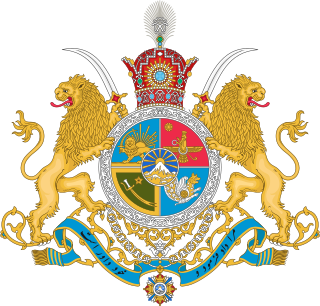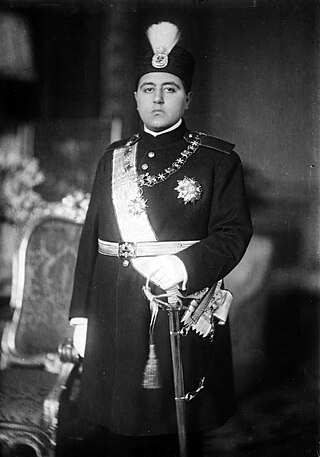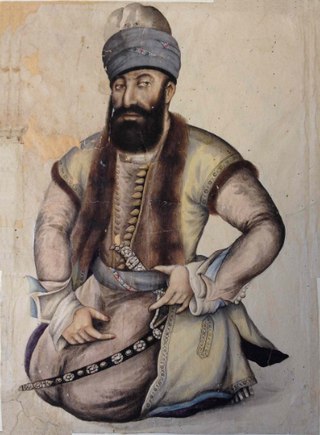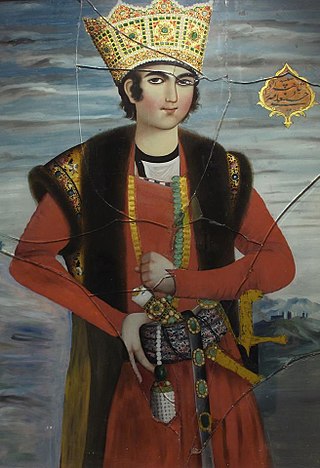| |||||
| Decades: | |||||
|---|---|---|---|---|---|
| See also: | Other events of 1797 Years in Iran | ||||
The following lists events that have happened in 1797 in the Qajar dynasty , Iran.
| |||||
| Decades: | |||||
|---|---|---|---|---|---|
| See also: | Other events of 1797 Years in Iran | ||||
The following lists events that have happened in 1797 in the Qajar dynasty , Iran.

The Pahlavi dynasty was the last Iranian royal dynasty that ruled for roughly 53 years between 1925 and 1979. The dynasty was founded by Reza Shah Pahlavi, a non-aristocratic Mazanderani soldier in modern times, who took on the name of the Pahlavi language spoken in the pre-Islamic Sasanian Empire to strengthen his nationalist credentials.

The Qajar dynasty was an Iranian royal dynasty founded by Mohammad Khan of the Qoyunlu clan of the Turkoman Qajar tribe.

Ahmad Shah Qajar was the shah of Iran (Persia) from 16 July 1909 to 15 December 1925, and the last ruling member of the Qajar dynasty.

Agha Mohammad Khan Qajar, also known by his regnal name of Agha Mohammad Shah, was the founder of the Qajar dynasty of Iran, ruling from 1789 to 1797 as Shah. Originally a chieftain of the Quwanlu branch of the Qajar tribe, Agha Mohammad Khan was enthroned as the king of Iran in 1789, but was not officially crowned until March 1796, having deposed Lotf Ali Khan of the Zand dynasty in 1794.

Mohammad Ali Shah Qajar was the sixth shah of the Qajar dynasty and remained the Shah of Iran from 8 January 1907 until being deposed on 16 July 1909. He was furthermore the grandson of Iran’s early moderniser Amir Kabir, through the maternal side.

Mohammad Shah was the third Qajar shah of Iran from 1834 to 1848, inheriting the throne from his grandfather, Fath-Ali Shah. From a young age, Mohammad Mirza was under the tutelage of Haji Mirza Aqasi, a local dervish from Tabriz whose teachings influenced the young prince to become a Sufi-king later in his life. After his father Abbas Mirza died in 1833, Mohammad Mirza became the crown prince of Iran and was assigned with the governorship of Azarbaijan. After the death of Fath-Ali Shah in 1834, some of his sons including Hossein Ali Mirza and Ali Mirza Zel as-Soltan rose up as claimants to the throne. With the support of English and Russian forces, Mohammad Shah suppressed the rebellious princes and asserted his authority.

Fath-Ali Shah Qajar was the second Shah of Qajar Iran. He reigned from 17 June 1797 until his death on 24 October 1834. His reign saw the irrevocable ceding of Iran's northern territories in the Caucasus, comprising what is nowadays Georgia, Dagestan, Azerbaijan, and Armenia, to the Russian Empire following the Russo-Persian Wars of 1804–1813 and 1826–1828 and the resulting treaties of Gulistan and Turkmenchay. These two treaties are closely tied to Fath-Ali Shah's legacy amongst Iranians, who often view him as a weak ruler.

Mohammad Karim Khan Zand was the founder of the Zand dynasty, ruling all of Iran (Persia) except for Khorasan from 1751 to 1779. He also ruled over some of the Caucasian lands and occupied Basra for some years.
Abol-Fath Khan Zand was the third Shah of the Zand dynasty, ruling from March 6, 1779, until August 22, 1779.

Fath-Ali Khan Qajar was the chieftain of the Ashaqa-bash branch of the Qajar tribe at Astarabad during the collapse of the Safavid dynasty of Iran.

Hajji Ebrahim Shirazi, also known by his honorific title E'temad ol-Dowleh, was an Iranian statesman who served as the kalantar of the city of Shiraz during the late Zand era and later as the first grand vizier of Qajar Iran.

Lotf Ali Khan was the last Shah of the Zand dynasty. He ruled from 1789 to 1794.

The Tabriz Khanate was a Caucasian Khanate from 1757 to 1799, centered around Tabriz and led by members of the Turkified Kurdish Donboli tribe.

Mohammad Taqi Mirza Hessam os-Saltaneh was a Persian Prince of the Qajar dynasty, son of Fath Ali Shah. He was Governor-General (beglerbegi) of Kermanshah and of Boroujerd.

The Guarded Domains of Iran, alternatively the Sublime State of Iran and commonly called Qajar Iran, Qajar Persia or the Qajar Empire, was the Iranian state under the rule of the Qajar dynasty, which was of Turkic origin, specifically from the Qajar tribe, from 1789 to 1925. The Qajar family took full control of Iran in 1794, deposing Lotf 'Ali Khan, the last Shah of the Zand dynasty, and re-asserted Iranian sovereignty over large parts of the Caucasus. In 1796, Agha Mohammad Khan Qajar seized Mashhad with ease, putting an end to the Afsharid dynasty. He was formally crowned as Shah after his punitive campaign against Iran's Georgian subjects.
The following lists events that have happened in 1907 in the Qajar dynasty.
The following lists events that have happened in 1909 in the Qajar dynasty, Iran.

Hossein Qoli Khan Qajar was the Qajar chieftain of the Qoyunlu branch from 1759 till his death in 1777 and brother of the founder of the Qajar dynasty of Iran Agha Mohammad Khan Qajar.

Hossein Ali Mirza, a son of Fath-Ali Shah, was the Governor of Fars and pretender to the throne of Qajar Iran.
Ali-Qoli Khan Qajar was a son of Mohammad Hasan Khan Qajar and half-brother of Agha Mohammad Khan Qajar, the founder of the Qajar dynasty of Iran. Unlike Agha Mohammad Khan's full brothers, Ali-Qoli Khan served loyally from the outset and supported, for around twenty years, Agha Mohammad Khan's conquest for control over all of Iran. Following Agha Mohammad Khan's assassination in 1797, he unsuccessfully tried to claim himself as his brother's rightful successor. Ali-Qoli Khan was eventually blinded and exiled by his nephew Baba Khan, who would ascend the Iranian throne as Fath-Ali Shah Qajar.